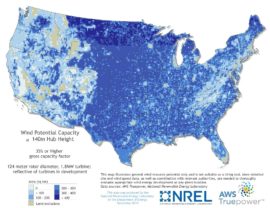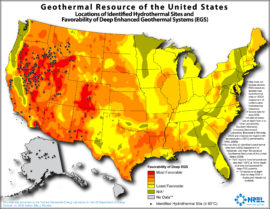|
Appalachia Can’t Shift From Coal To Clean Easily
The Appalachia region of the USA was a key factor in the recent US election. The people there have become the defining puzzle of US politics, with the most recommended book right now on the left and right being Hillbilly Elegy by JD Vance.
That book does an excellent job explaining who the people are, how they think, and what motivated them and the white working class to support Trump to the extent that they did. But it doesn’t answer the question of why the Appalachian region doesn’t just shift to clean technologies instead of clinging to the hopes of a coal resurgence which isn’t coming.
The reasons for slower rather than faster movement are always complex, and this is true of Appalachia as well. There are economic reasons, resource constraints, and purely human factors at play.
What Exactly is Appalachia?

The region is a 205,000 square mile (531,000 square kilometre) chunk of the eastern United States, starting in the southern portions of New York and Pennsylvania and stretching down to the northern parts of Mississippi and Alabama. That’s almost the size of France and bigger than Germany, Japan, and Vietnam, to provide a few examples. For further context, it’s about 1,000 miles or 1,600 kilometres from north to south. The Appalachian Trail, a famous hiking trail of the region, is over 2,000 miles (3,200 kilometres).
That covers a lot of territory, a lot of different cultures, a fair amount of history, and a population of about 25 million. The population makes it bigger than Australia and about 150 other countries. The size and number of people mean that any assertion of it being homogenous has to be taken as an absurd generalization, but breaking it down can provide useful analysis.
To single coal out, there were about 785,000 people employed in the coal industry in the USA in 1910 when Appalachia dominated that industry. Now, there are about 80,000 and many of those jobs are in the west in new coal basins. Fewer than 60,000 people of the 25 million in the region still work in the coal industry. Appalachia’s coal industry employment has been in decline for decades because of automation and shifting demand.
It’s a region that was blessed mostly with three things: lumber, coal, and natural beauty. Now, it’s reduced to a lower degree of natural beauty due to the extraction of as much lumber and coal as they could manage over the past couple of hundred years. The lumber and coal industries still exist as shadows of their former selves, but the wealthy spots of the region — and there are several — are cities that have reinvented themselves for the information age.
Let’s explore the reasons why the poorer parts of the region can’t simply shift to clean energy jobs from the coal jobs which were such a dominant theme of the past months.
Pure Economics & Logistics
Wind energy wasn’t particularly viable in Appalachia until recently. With the new larger, longer-bladed, and more effective wind turbines which started appearing around 2010, Appalachia’s wind resource is now much more economically interesting. However, there isn’t a strong web of industry supplying services companies in the region yet and it will take several years for that to grow to the point where large numbers of megawatts (MW) of wind capacity can be built. Siting and building wind farms is still more challenging in the hills of Appalachia than on the Great Plains.
Similarly, solar energy has plummeted in cost to the point where it’s highly competitive outside of flat and sun-baked environs. However, if you live in the hills, there are greater challenges with siting large-scale solar as well.
Geothermal has some potential, too, but the focus has rightly been on the much more tectonically active west coast which has much better resources. With advances in this space, there’s some potential in Appalachia, but once again no industry. The good news is that geothermal is much more tightly aligned with coal mining skills, even if the physical resource is imperfect.
Wind and solar are now viable in Appalachia, but it’s going to take time to build a significant industry there for them and it’s not the first place people will build the industry. Coastal regions are flatter and more viable.
People vs Resource Locations

The economies of the region are pretty disparate, as well as the cultures that it encompasses.
When we talk about economically distressed Appalachian communities, they are typically the ones most focussed on now moribund resource extraction communities such as coal and lumber.

Let’s compare an NREL map of potential wind resource areas showing where there are more and fewer square kilometres of viable resource to the maps of Appalachia. We can see that Appalachia has sites available, but they are sparser than the great plains or the coast regions of the east coast. That’s a challenge for coal communities.
The distressed communities aren’t necessarily where the best wind and solar resources are in Appalachia, so saying that they should transition implies significant regional travel distances, even in the hundreds of miles. If you are poor, traveling a hundred miles for work can be a major fiscal outlay. Traveling 300 miles can be an odyssey. Getting entire work populations to sites that might be sparsely populated today but have the best wind resources is challenging.
As can been seen from the geothermal resource map, there’s a band of better geothermal resource running through Appalachia, but it’s much lower grade than the hotspots on the west coast. And, once again, the geothermal resource is not going to be next door to the human resources. Remember again that the region is 1,000 miles or 1,600 kilometres of twisting, winding roads and steep grades. Getting from point A to point B isn’t trivial.

When your life was based on getting home after your shift in the local mine and being with your family, being required to spend days and weeks apart from them is a struggle, and not one that everyone can accept.
Human Perspectives
There are a handful of major factors associated with human change that make it more difficult for Appalachian coal workers to shift to clean energy as well.
Self-identity
The people in distressed coal-mining communities identify as coal miners, as fossil fuel industry people. They often, but far from uniformly, reject renewable energy, as it is both outside of their self-identity and, further, perceived as a threat. Humans have challenges with that. There is a simple perspective that it’s all energy and all resource extraction, but that’s a harder sell than it sounds.
Hostility of the minority
Shifting to renewables entails joining the enemy in at least a subset of the populace’s eyes, and a smaller subset of them will be openly hostile and possibly violent. Societal forces of hostility to change grow in depressed regions despite the greater need for change.
Poor mapping of skills
Being a miner entails an overlapping set of skills with being a wind or solar farm installer. But the overlap isn’t contiguous by any stretch, and there are people with 20 year careers doing stuff which is completely unnecessary in the renewables field. Outside of electricians, everyone will start from zero and everyone will have to retrain. A subset of miners would be able to start quickly in geothermal, but still would require retraining.
Underinvestment in retraining
At the state and federal level, there’s been a greater history of support for the coal industry than for retraining people. Clinton’s campaign had a rock solid retraining program in place and I’d be willing to bet big bucks that she and her team had a much richer understanding of the challenges and opportunities than I do. But she lost. Obama had major challenges at the beginning of his 8 years that diluted focus on this key portion, somewhat to Clinton’s detriment in 2016. Under Trump, there will be no real relief for the Appalachian coal industry because it’s been dying for decades and the license to pollute streams that Congress just approved is at best palliative care.
Also see:
Stabbed In The Back! ExxonMobil Throws Shade At US Coal Industry
Stabbed In The Back, Part Deux: Coal Gets Another Brushoff
Coal Under The Bus, Part Infinity: Trump Likes Rex Tillerson For Sec’y Of State
Everybody Hates Coal! National Petroleum Council Member Weighs In
Appalachia employment is a problem a couple of hundred years in the making. It won’t be solved overnight and there is no magic bullet. In the USA’s Colonial Era, 90% of people were involved in agriculture in some manner or other. Now, ~2% are. Cities have grown massively while many rural towns have dwindled in population. The same will occur and is occurring in Appalachia, but it’s a hard and bitter process. Families and organizations are ripped apart by it.
There will be some jobs in the region due to wind, solar, and geothermal energy. It’s probable that they could provide tens of thousands of jobs for workers in the region. But there are never going to be close to the 785,000 coal jobs of 1910.
Check out our new 93-page EV report.
Join us for an upcoming Cleantech Revolution Tour conference!
How much money can a solar roof save you in Pennsylvania?
Profit from your roof space: find local deals on solar in your area, eliminate your power bill, and join the solar revolution.
18324
Calculate My Savings!
Click to share on Reddit (Opens in new window) Click to share on Google+ (Opens in new window) 8Click to share on LinkedIn (Opens in new window)8 Click to share on Twitter (Opens in new window) Click to share on Flipboard (Opens in new window) Click to email this to a friend (Opens in new window) 4Click to share on Pinterest (Opens in new window)4 75Click to share on Facebook (Opens in new window)75 More
Tags: Appalachia, coal jobs, Donald Trump, Energy, Hillary Clinton, NREL, Republicans, united states, US
===================================================================================
About the Author
Michael Barnard For the past several years Michael has been analyzing and publishing reports and articles on decarbonization technologies, business models and policies. His pieces on electrical generation transformation and electrification of transportation have been published in CleanTechnica, Newsweek, Slate, Forbes, Huffington Post, Quartz, RenewEconomy, RenewablesInternational and Gizmag, as well as included in textbooks. Third-party articles on his analyses and interviews with Mike have been published in dozens of news sites globally and have reached #1 on Reddit Science. Much of his work originates on Quora.com, where Mike has been a Top Writer annually since 2012. He also has published a climate-fiction novel, Guangzhou Future Tense.
|




